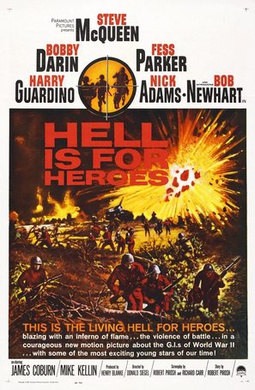“Hell
is for Heroes” is an anti-war movie released in 1962. The movie originated with writer Robert
Pirosh who had already scored with “Battleground”. Pirosh was a veteran of WWII. He had been a Master Sergeant in the 35th
Division and served in the Battle of the Bulge.
He was awarded the Bronze Star.
The incident in the movie was supposedly based on his experiences. Unfortunately his war experiences did not
prepare him for working with Steve McQueen.
McQueen arrived on set unhappy and stayed that way. He did not want to be in the film and made it
clear to everyone involved. It was not
method acting. He was a huge pain in the
ass and Pirosh (who was supposed to direct) walked out on the production. Don Siegel (his only war movie) replaced him
which was probably for the better as he was able to stand up to the obstinate
star. The filming was an unpleasant
experience for all involved with his fellow actors being nettled by McQueen’s
surliness. Siegel put his stamp on the
movie by insisting that it be bleakly anti-war.
He took all of Pirosh’s black comedy out, but the studio forced him to
include the Bob Newhart telephone monologue.
The
movie is set near the Siegried Line in 1944.
A squad is sent to an outpost to deceive the Germans into remaining on
the defensive. It is your typical
heterogeneous unit of potential survivors.
Thrown into the mix is the recent replacement named Reese (McQueen). He comes with a chip on his shoulder the size
of a log. He was recently demoted and
is surly about it. It seems he is a
decorated warrior who “cracks up when the pressure is off.” On the other hand, his comrades are not happy with the advent of
new pressure. Their mission is to
maintain a stretch of the front line and make the more numerous Germans across
no man’s land think they are a much larger unit. This involves stunts like rigging up a jeep
to sound like a tank. When they discover
a listening device in their bunker, this gives Newhart (who plays clerk PFC Driscoll) to do one of
his popular telephone routines pretending they have a much larger force. This is one of the most bizarre moments in war movie history.
The
attempts at deception are only semi-successful because the Germans raid during
the night and let the whittling begin.
We started with eight and won’t end up with eight. For some faux tactical reason, Reese
convinces the men that tit deserves tat.
He leads a raid on a German pill box.
This involves a suspenseful crawl through a mine-field (suicidally using
their hands instead of knives to probe).
Reese sets himself up for redemption in the climactic assault against
the Siegfried Line.
“Hell
is for Heroes” has developed a cultish reputation over the years. This is in spite (or due to) its limited
budget and Siegel’s direction. The movie
was filmed mainly at the studio and they should have been thankful they did not
have to film in Siegel’s back yard since the suits were very stingy. The cast was constantly angry about things
like malfunctioning weapons. The movie
ends abruptly because they ran out of film!
The obstacles overcome (including McQueen) adds to the mystique of the
movie.
The
cast is first rate with James Coburn, Bobby Darin, Fess Parker, and Nick
Adams. McQueen dominates as was his
wont, but he gives a remarkable performance as one of the iconic anti-heroes. Of course, you could argue that he was not
actually acting. He was acting out. He certainly has the thousand yard stare down
pat. It was Newhart’s debut and his
phone routine, while hilarious, is out of place in this particular film. Unfortunately, other than the Reese
character, there is little character cdevelopment.
The
movie has a made-for-television feel to it -
specifically, “Combat!” (which Pirosh went on to create). The movie even has music straight out of that
TV series. The dialogue is sparse with
little of the soldier banter you would expect from men awaiting possible
death. The action is well-staged with
some good combat scenes. At one point
Reese is fighting hand-to-hand and throws his helmet at a German. Most of the action takes place at night which
adds to the vibe. This was not a Siegel
touch, but instead was called for because of the brutally hot daytime
temperatures. The cinematography has
some bells and whistles and the sound is good for a low budget effort. The set is nice with authentic looking
dragon’s teeth and fox holes. The
weapons are fine with Reese using a grease gun (a very cranky M3), but not
carrying the correct ammunition. The
technical adviser must have slept through most of the production.
Pirosh’s
script was reworked a bit and ended up being Siegel-worthy bleak. It does not avoid clichés as it has a fallen
hero who finds redemption. The old heel
to hero arc. It is firmly in the “who
will survive?” subgenre. It lacks in
realism as some of the deceptions are borderline silly, but it’s hard to get
upset with a movie that does not care what you think about Newhart doing one of
his comedy routines.
Does it crack my 100 Best Movies list? I doubt it, but it is a must-see for war movie buffs
GRADE = B-

No comments:
Post a Comment
Please fell free to comment. I would love to hear what you think and will respond.